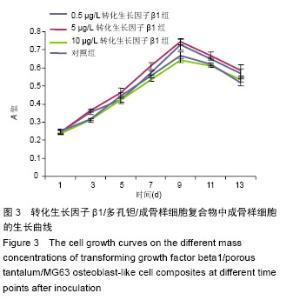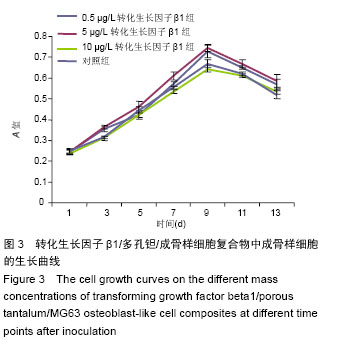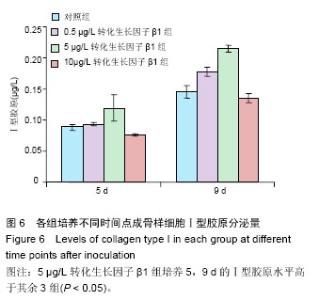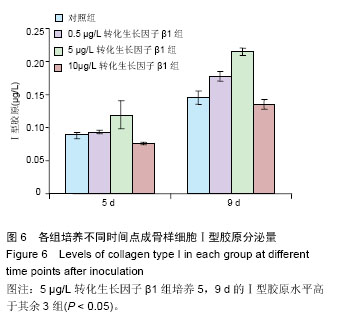| [1] Mrosek EH,Schagemann JC,Chung HW,et al.Porous tantalum and poly-epsilon -caprolactone biocomposites for osteochondral defect repair: preliminary studies in rabbits.J Orthop Res. 2010;28(2):141-148.[2] 郑凯,于秀淳,郭征,等.生物金属材料在骨科的应用及发展[J].生物骨科材料与临床研究,2013,10(2):31-33.[3] Dabrowski B,Swieszkowski W,Godlinski D,et al.Highly porous titanium scaffolds for orthopaedic applications.J Biomed Mater Res B A ppl Biomater. 2010;95(1):53-61.[4] Cardaropoli F,Alfieri V,Caiazzo F,et al.Manufacturing of porous biomaterials for dental implant applications through selective laser melting.Adv Mater Res.2012; 6(535-537):1222-1229.[5] 李琪佳,王茜,甘洪全,等.多孔钽材料细胞毒性、生物相容性及体内成骨性研究[J].中华骨科杂志, 2014,34(9):954-961.[6] 陈良建,汪瑞芳,郭小平,等.载 TGF-β1 明胶微球涂层多孔钛对MG63 细胞功能的影响[J].中南大学学报(自然科学版),2011,42(8):2266-2273.[7] Crane JL,Cao X.Bone marrow mesenchymal stem cells and TGF-β signaling in bone remodeling.J Clin Invest.2014;124(2):466-472. [8] 张岭,李琪佳,赵季华,等.医用多孔钽材料复合大鼠软骨细胞的生长特性及功能变化[J].解放军医学杂志, 2014, 39(6): 464-469.[9] Bobyn JD,Stackpool GJ,Hacking SA,et al. Characteristics of bone ingrowth and interface mechanics of a new porous tantalum biomaterial.J Bone Joint Surg Br.1999;81(5):907-914.[10] de Wild M,Schumacher R,Mayer K,et al.Bone regeneration by the osteoconductivity of porous titanium implants manufactured by selective laser melting:a histological and microCT study in the rabbit. Tissue Eng Part A 2013,19(23-24):2645-2654.[11] Hao L,Wei Y,Li J,et a1.Initial osteoblast functions on Ti-5Zr-3Sn-5Mo-15Nb titanium alloy surfaces modified by microarc oxidation.J Biomed Mater Res A. 2010; 92(2):432-440.[12] Tang Z,Xie Y,Yang F,et al.Porous tantalum coatings prepared by vacuum plasma spraying enhance bmscs osteogenic differentiation and bone regeneration in vitro and in vivo.PLos One.2013;8(6):e66263. [13] Sagomonyants KB,Hakim-Zargar M,Jhaveri A,et al.Porous tantalum stimulates the proliferation and osteogenesis of osteoblasts from elderly female patients.J Orthop Res.2011;29(4):609-616.[14] Christie MJ.Clinical applications of trabecular metal. Am J Orthop.2002;31(4):219-220. [15] 耿丽鑫,甘洪全,王茜,等.国产多孔钽对成骨细胞生物相容性及其相关成骨基因表达的影响[J].第三军医大学学报, 2014,36(11):1163-1167.[16] 甘洪全,李琪佳,王茜,等.国产多孔钽材料兔髌腱内植入形态学特点及生物相容性评价[J].中国修复重建外科杂志, 2014,28(4):452-456.[17] 甘洪全,刘鑫,赵济华,等.国产多孔钽材料兔竖脊肌植入组织学及生物学效应[J].南京医科大学学报, 2014,34(5): 611-616.[18] Fox P,Pogson S,Sutcliffe CJ,et al.Interface interactions between porous titanium/tantalum coatings, produced by Selective Laser Melting(SLM), on a cobalt-chromium alloy.Surf Coat Techonl. 2008;202(20):5001-5007.[19] Welldon KJ,Atkins GJ,Howie DW,et al.Primary human osteoblasts grow into porous tantalum and maintain an osteoblastic phenotype.J Biomed Mater Res A.2008; 84(3):691-701.[20] Chen G,Deng C,Li YP.TGF-β and BMP signaling in osteoblast differentiation and bone formation.Int J Biol Sci.2012;8(2):272-288.[21] 郑纪伟,郭宏亮,孟尧,等.转化生长因子β1对钛表面成骨细胞中骨钙素基因表达的影响[J].口腔医学研究, 2012, 28(9):868-871. [22] 卢卫忠,唐康来,杨柳,等.TGF-β对成骨细胞的作用[J].第三军医大学学报, 2000,22(1):99-102.[23] 郑纪伟,韩斐斐,王瑾,等.TGF-β1对钛表面成骨相关蛋白基因表达的影响[J].中华老年口腔医学杂志, 2011,9(2): 65-69. [24] 朱奇,樊明文,边专,等.转化生长因子β1mRNA在鼠磨牙形态发生过程中表达的研究[J] .中华口腔医学杂志, 2001, 36(2):130-132.[25] 张小恒,余占海,张国英,等.转化生长因子β1对大鼠牙周组织中白细胞介素,骨钙素水平的影响[J].口腔医学研究,2010,26(2):171-174. |













